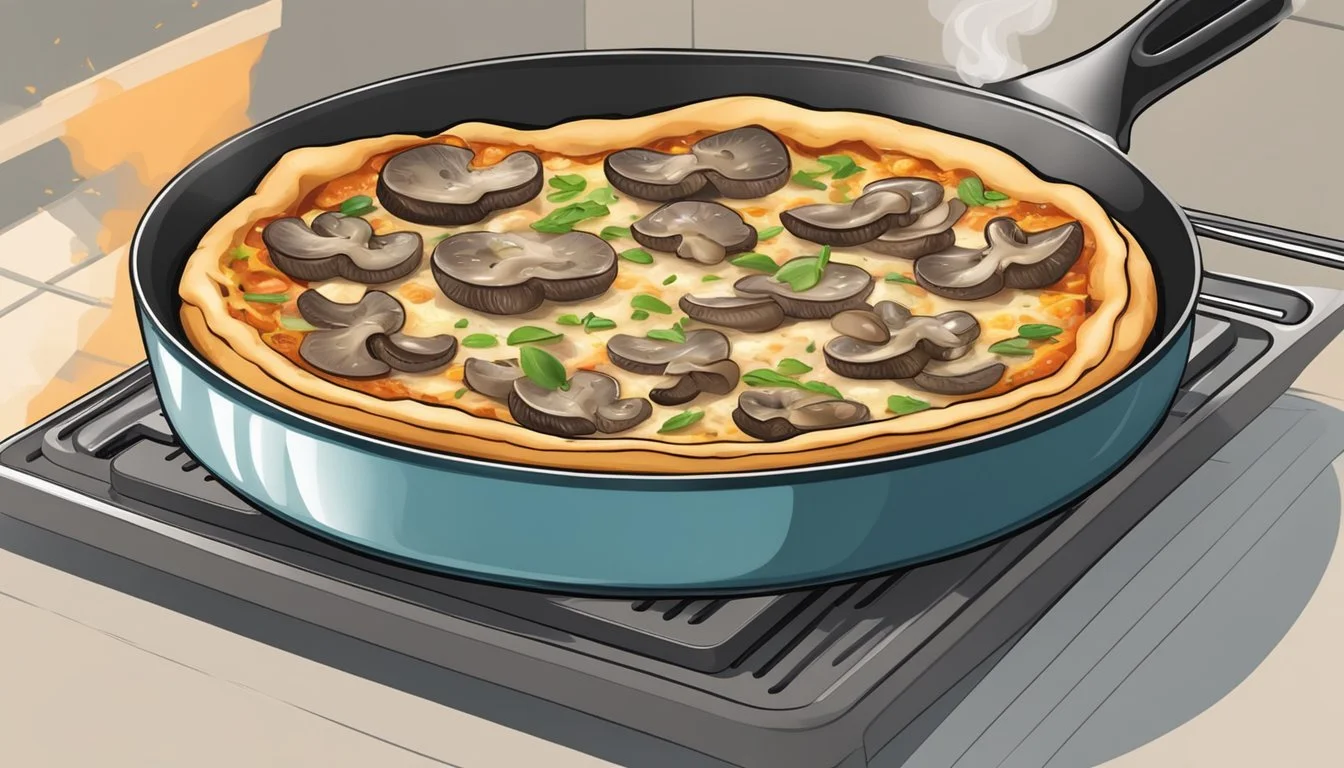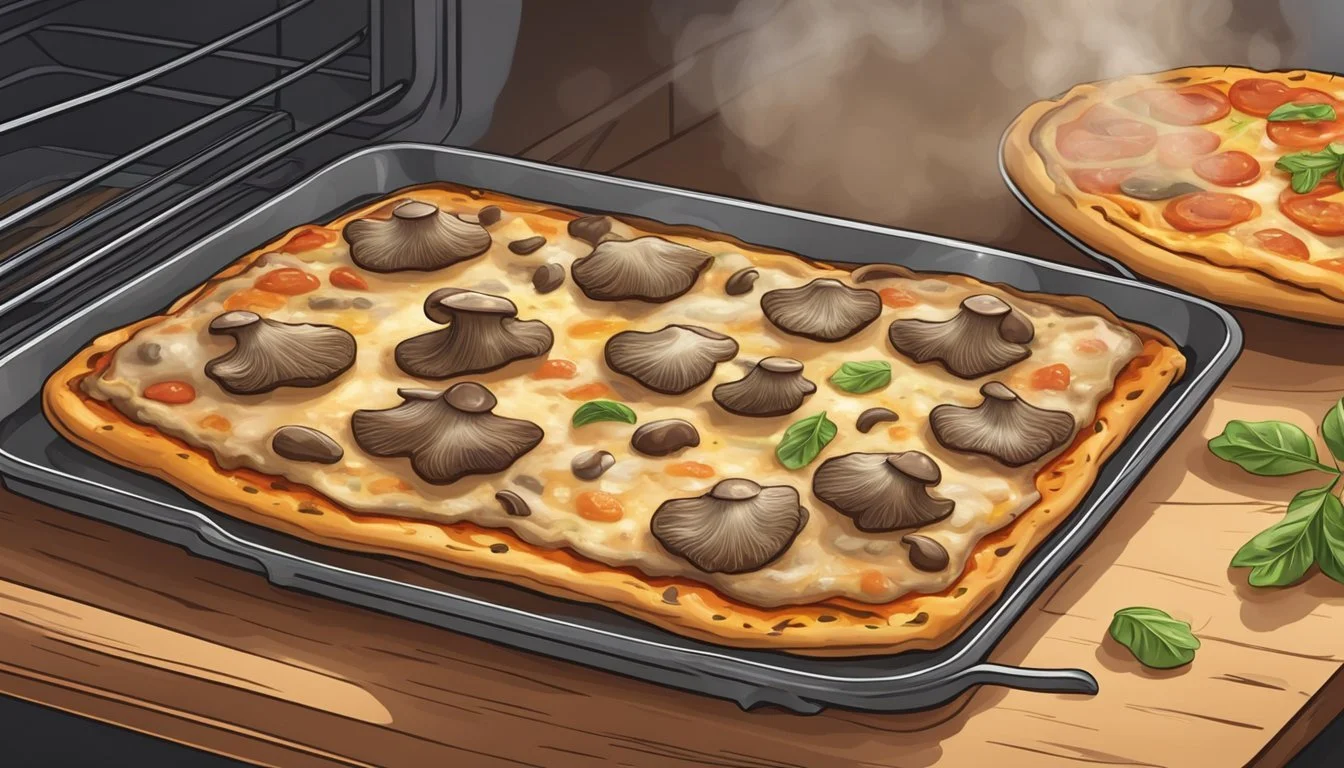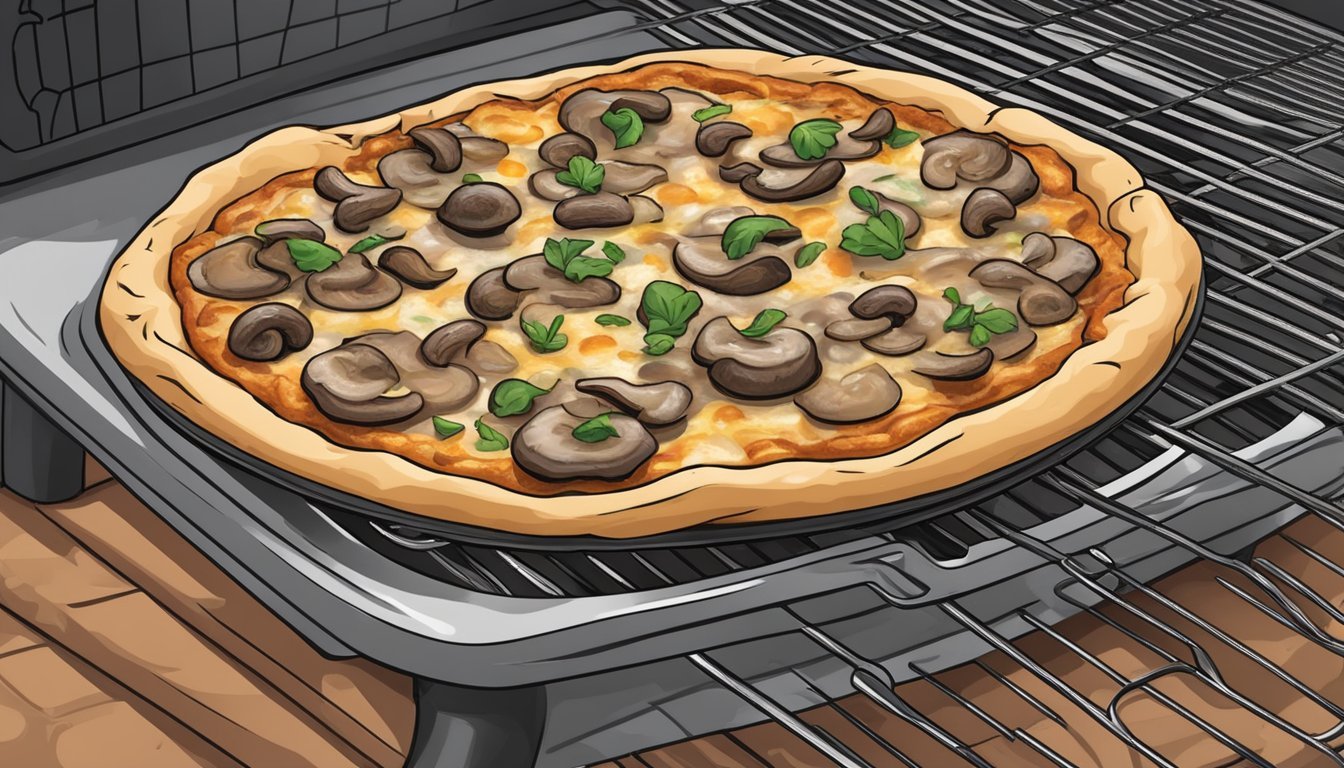Best Way to Reheat Mushroom Pizza
Crispy Crust, Tender Toppings Guide
Reheating leftover pizza (What wine goes well with pizza?) can be as much an art as making it fresh. Few foods are as unanimously loved as pizza, but the sogginess that often accompanies microwaved leftovers can dampen the experience. Finding the perfect method to revitalize a slice of mushroom pizza is key to enjoying it almost as much the second time around. The aim is to restore the crust's crispiness without drying out the tender mushrooms (What wine goes well with mushrooms?) and cheese on top.
Properly reheated, mushroom pizza can rival its freshly-baked predecessor, with a crust that snaps delightfully under pressure and mushrooms that maintain their succulence. Achieving this balance is about more than just the application of heat; it involves a careful choice of reheating environment and an understanding of how to retain moisture where it's wanted while banishing it from where it's not.
Connoisseurs agree that the oven or toaster oven provides the best results when reheating pizza. Evenly distributing heat across the slice, a well-calibrated oven can return the life to the crust while gently warming the toppings. For the mushroom lover, this means maintaining the fungi's natural juices without making the base soggy, a hallmark of perfectly reheated pizza.
Essential Reheating Principles
When reheating Mushroom Pizza to achieve a crust that's crispy and mushrooms that remain tender, it’s critical to apply appropriate reheating principles. These ensure the preservation of texture, flavor, and food safety.
Understanding Texture and Moisture
The texture of the pizza's crust is greatly affected by how moisture is managed during reheating. Ensuring that steam can escape is paramount to maintaining a crispy crust. Conversely, mushrooms, being moisture-rich, need gentle warming to stay tender. An oven set to a medium-low temperature, for example, circulating at 275-350 degrees Fahrenheit, can achieve this balance.
Role of Heat Distribution
Even heat distribution is essential for reheating pizza uniformly. Using a preheated oven or an air fryer can provide consistent heat distribution. For a microwave reheating method, placing a mug of water alongside the pizza moderates the internal humidity, protecting the texture.
Safety and Food Quality
Before reheating, leftover pizza should be safely storeD; refrigerating promptly ensures the quality of the pizza. It should reach room temperature briefly before reheating, which aids in even heat penetration. This minimizes the risk of bacteria growth while maintaining the pizza's overall quality.
Preserving Original Flavors
The flavors of the pizza can alter depending on the reheating method used. To preserve the original taste, fresh toppings may need to be removed before reheating and then added back afterward to avoid overcooking. Gentle reheating in the oven can help preserve the delicate balance of flavors, often resulting in the toppings heating through just as the crust becomes golden brown.
Choosing the Right Method
The best way to reheat depends on the desired balance between speed and convenience:
Oven: Ideal for a crispy crust and overall texture, but takes longer.
Microwave: Quick, but may result in a softer crust. A mug of water can help mitigate this.
Stovetop: A skillet can be used for a crispy bottom if covered to trap steam momentarily.
Air Fryer: Effective for a small number of slices, offering quick, crispy results.
Each method requires careful attention to reheating time and temperature to ensure the pizza's integrity is upheld.
Preparing for Reheating
Proper preparation is essential for reheating leftover mushroom pizza so that the crust stays crispy and the mushrooms remain tender.
Bringing Pizza to Room Temperature
One should remove the cold pizza from the fridge and allow it to sit at room temperature for about 15 minutes before reheating. This step ensures that the pizza heats evenly, preventing the crust from becoming tough and the toppings from overheating.
Prepping Your Tools
Oven Method: Preheat the oven to at least 350°F. Meanwhile, prepare a rimmed baking sheet by lining it with aluminum foil or parchment paper for easy clean-up. Alternatively, a preheated pizza stone can mimic a pizza oven's hot surface for an even crispier crust.
Skillet Method: For those preferring a stovetop approach, a nonstick skillet or a cast-iron pan is ideal. Heat the skillet over medium heat without adding any oil or condiments. A skillet will reheat the crust effectively, making it crispy while keeping mushroom tops tender. If using aluminum foil, wrap the pizza slices loosely to allow for proper heat circulation, avoiding direct contact between the cheese and foil.
One can also consider using a flat, cast-iron pan, placing it in the oven to preheat along with the oven, and then transferring the room temperature pizza directly onto the hot surface. This method helps in achieving a crisp bottom crust while avoiding sogginess.
Oven Reheating Method
When reheating mushroom pizza in the oven, the goal is to attain a crispy crust while keeping the mushrooms tender. The method involves using a baking sheet, setting the correct temperature and timing, and optionally adding moisture to retain the tenderness of the mushrooms.
Using a Baking Sheet
To reheat a slice of mushroom pizza while preserving the crispiness of the crust, one should use a baking sheet. It's important to:
Preheat the baking sheet in the oven before placing the pizza on it. This ensures the bottom of the crust starts to crisp up immediately from the direct heat.
Place the pizza directly on the preheated baking sheet, eliminating the need for aluminum foil. Foil can sometimes prevent the crust from becoming crispy.
Oven Temperature and Timing
For optimal results:
Preheat the oven to 350°F (175°C).
Once the oven is heated, and the baking sheet is hot, place the pizza in the oven.
Bake the pizza slice for approximately 8-10 minutes. Adjust the time if the slice is unusually large or thick.
Crust Type Bake Time Temperature Thin Crust 5-7 min 350°F Thick Crust 7-9 min 350°F
Adding Moisture for Tenderness
To ensure the mushroom toppings remain tender, one can:
Place a small cup of water on a separate rack in the oven during reheating. The steam will help to keep the mushrooms from drying out.
Keep an eye on the pizza to prevent the crust from getting soggy; the objective is a gentle rehydration of mushrooms, not to steam the pizza.
Stovetop Reheating Technique
Reheating mushroom pizza on a stovetop allows for a crispy crust and tender mushrooms while ensuring the cheese is perfectly melted. By selecting the right pan, managing the stovetop heat, and checking for the ideal doneness, one can rejuvenate a slice of pizza to its original glory.
Pan Selection and Preparation
Choosing the correct pan is crucial for the desired outcome. A cast iron pan is recommended due to its even heat distribution, but a non-stick skillet can also be effective. Before heating the pan on the stove, one should lightly coat the skillet's surface with oil, preferably extra virgin olive oil, to create a non-stick barrier that contributes to the crust's crispiness.
Managing Heat and Coverage
Once the pan is prepared, heat it over medium heat to avoid burning. Place the slice of mushroom pizza in the skillet, ensuring not to overcrowd. Cover the pan with a lid to trap heat, creating an oven-like environment that evenly melts the cheese and warms the mushrooms. The covered skillet method also prevents the cheese from becoming too gooey or drying out.
Checking for Doneness
After a few minutes, one should check the pizza. The crust should be golden brown and crispy, while the cheese should be just melty enough without being overly gooey. The mushrooms on top will have become warm and tender. Adjust the stovetop heat as needed and return the lid to finish the reheating process to the desired level of doneness.
Alternative Reheating Methods
When reheating mushroom pizza, preserving the crispy crust and tender mushrooms is paramount. Each method may vary in speed and convenience, with trade-offs in texture and taste.
Toaster Oven Process
The toaster oven offers a balance of speed and preserved texture. One can reheat pizza effectively by:
Preheating the toaster oven to 350°F.
Placing the pizza on a nonstick baking sheet or toaster oven tray.
Heating for about 5-10 minutes, monitoring to ensure the crust crisps without burning.
This method works well for reheating multiple slices at once and maintaining a crispy crust.
Microwave Technique
The microwave is the fastest method, although it can affect texture. To mitigate sogginess:
Place the pizza on a microwave-safe plate.
Cover it with a paper towel to absorb moisture.
Heat on high power for 30-60 seconds.
This technique is not ideal for crispiness but offers convenience and speed for those in a rush.
Air Fryer Approach
An air fryer provides a crisp crust and can handle leftovers well. The process includes:
Preheating the air fryer to 320-350°F.
Putting the pizza in the air fryer basket without overlapping.
Reheating for 3-4 minutes or until desired crispness is achieved.
This method quickly warms pizza while keeping the crust crispy and mushrooms tender.
Advanced Reheating Tips
These reheating strategies are tailored to ensure your mushroom pizza retains its original flavor and texture, focusing on a crispy crust and tender mushrooms.
Combining Methods for Perfection
For optimal results, one may combine oven and skillet reheating methods. First, preheat the oven to 275°F. Place the pizza on a baking sheet and warm it for about 10 minutes. Then, transfer the pizza to a hot skillet on medium heat. Heat for a minute or two until the crust achieves desired crispiness. This method keeps the crust crispy, cheese perfectly melted, and mushrooms tender.
Dealing with Starch Molecules
Starch retrogradation, the process by which starch molecules in the pizza crust crystallize and harden, can be mitigated. To counteract this, one should:
Preheat the oven to a low temperature, around 275°F.
Place the pizza on a baking surface such as pizza stone or baking sheet.
Heat until the cheese is just melted. Heating slowly allows the starch molecules to rehydrate and soften, ensuring the crust regains its original crisp texture.
Adjusting for Different Toppings
Toppings, particularly mushrooms, require special consideration:
For thicker cut mushrooms: Lay a piece of aluminum foil lightly over the pizza to prevent them from drying out in the oven.
For diverse toppings: Adjust the time and temperature accordingly. Vegetables may require less reheating time to avoid overcooking, while meats should be thoroughly heated to a safe temperature.
Each topping interacts differently with heat, and mushrooms tend to lose moisture quickly. Careful attention maintains their delicate texture.
Serving and Enjoying
When one has meticulously reheated their mushroom pizza to achieve a crispy crust and tender mushrooms, the final steps are essential to elevating the dining experience. Ensuring that each slice is garnished and paired correctly can transform a simple meal into a gourmet delight.
Final Touches Before Serving
One can enhance their mushroom pizza by adding fresh toppings after reheating. A light drizzle of extra virgin olive oil adds a subtle richness and can make the flavors pop. If the recipe calls for it, garnishing with fresh herbs like basil or arugula just before serving brings a bright note to the dish.
Pairing with Sides
Choosing the right side dishes can complement the savory flavors of the pizza. Consider the following pairings:
Mixed greens salad: A simple salad dressed with a balsamic vinaigrette balances the rich taste of the pizza.
Roasted vegetables: For a heartier companion, roasted garlic or cherry tomatoes can add both texture and depth.
Serving the right sides turns the reheated mushroom pizza into a full, satisfying meal.
Common Mistakes to Avoid
When reheating mushroom pizza, certain missteps can prevent achieving that desirable balance of a crispy crust and tender mushrooms. This section identifies typical mistakes and offers guidance on how to avoid them.
Overcrowding the Heating Surface
Placing multiple slices of leftover pizza too close together on a baking tray or other heating surfaces leads to steaming rather than reheating. This steam can result in a soggy crust instead of a crisp one. For optimal results, reheat only as many slices as can fit without touching.
Using Too Much Heat
Heating the pizza at full power or high temperatures might seem like a quick solution, but it often compromises the pizza's texture. Instead, it is better to reheat the pizza at a medium-high temperature to ensure the mushrooms don't dry out and the crust becomes crispy without burning.
Neglecting the Pizza Crust
A delicious reheated pizza has a crispy crust that rivals its initial fresh state. To achieve this, some prefer to use a pizza stone or preheated cast iron skillet, which uniformly heats the base and restores the crust's crispiness. Placing pizza directly on the oven rack is another effective method, provided it's done at a controlled temperature.
Forgetting to Hydrate Toppings
Mushrooms and other toppings can dry out during reheating. To retain their tenderness, one might consider covering the slices with aluminum foil or adding a small container of water in the oven to create a moist environment that encourages steam generation without making the crust soft.
Storage Advice for Leftover Pizza
Storing leftover pizza properly is essential to preserve its flavor and texture. This section covers effective methods for cooling, packaging, refrigerating, and freezing, specifically tailored for mushroom pizza.
Proper Cooling and Packaging
After enjoying a delicious mushroom pizza, one should allow the leftovers to cool down before storage to prevent the buildup of moisture, which could lead to a soggy crust. Leftover slices should be laid out on a flat surface, separated to avoid steaming. Packaging correctly is critical:
Place a single layer of pizza on a plate or a tray.
For homemade or frozen pizza that has been cooked, use parchment paper to separate layers if stacking is necessary.
Wrap the pizza tightly in aluminum foil or store it in an airtight container to keep out moisture and odors.
Refrigeration Considerations
Leftover pizza with mozzarella and mushrooms remains in optimal condition for up to three days when stored in the refrigerator. For best results:
Set the temperature of the fridge to below 40°F (4°C) to keep bacteria at bay.
Store the wrapped pizza on a shelf rather than in the door, where temperature fluctuations are greater.
Freezing and Thawing Practices
When the pizza will not be consumed within a few days, freezing is an option. To freeze leftover pizza:
Wrap individual slices in parchment paper, then aluminum foil, or place in airtight freezer bags.
Label with the date to keep track of how long it's been stored; mushroom pizza remains suitable for consumption for up to 2 months when frozen.
Thawing should be done in the refrigerator, naturally allowing slices to reach fridge temperature, which maintains the integrity of the mushrooms and crust.
Experimental Reheating on a Gas Grill
Reheating pizza on a gas grill can offer a crispy crust and preserve the tenderness of mushroom toppings, resembling the high-heat environment of a pizza oven.
Grill Setup and Heat Management
A gas grill should be preheated to a medium-high setting, aiming for a surface temperature around 500°F. One can use a grill thermometer to monitor this. It’s crucial to create zones of direct and indirect heat by only lighting one side of the grill burners. This method provides heat control, allowing the pizza to reheat evenly without burning the crust or toppings.
Direct Heat Zone: Place pizza directly over the burner for quick crisping of the crust.
Indirect Heat Zone: Move pizza away from the burner to continue reheating the toppings without overcooking.
Monitoring for Optimal Reheating
The pizza should be placed on the grill and the lid closed for uniform heat distribution. Keeping the lid down traps heat and mimics an oven-like environment, which is essential for achieving a crispy crust while ensuring that the mushroom toppings remain tender.
Duration: Typically, the pizza should reheat for around 5 to 8 minutes.
Frequency of Checking: Lift the lid to check on the pizza every couple of minutes to prevent overcooking.
Visual Cues: Look for melted cheese and a golden-brown crust as indicators that the pizza is properly reheated.
By monitoring the pizza and adjusting its position on the grill between direct and indirect heat zones, one ensures that each slice reaches its optimal reheating point.
Conclusion
In reheating leftover mushroom pizza, the goal is to achieve a balance between a melty cheese topping and a crispy crust, while also preserving the tenderness of the mushrooms. To do so, an oven is preferable, utilizing a mid-range temperature to gently warm the pizza through to the center without overcooking the edges.
Oven Reheating Method:
Preheat to 350°F (175°C).
Place the pizza on a baking sheet or pizza stone.
Bake for 10-12 minutes, checking for a golden brown crust and bubbling cheese.
Alternatively, for those who prefer a softer crust or are short on time, the microwave can reheat the pizza with the addition of a mug of water to keep the moisture balanced, microwaving in 30-second intervals.
Microwave Reheating Method:
Setup a microwavable plate with a side mug of water.
Heat in 30-second increments, checking for even warmth.
Reheating Tips:
Wrap the pizza loosely in aluminum foil if using an oven to prevent over-drying.
Avoid overheating to preserve the mushroom's tenderness.
Use a pizza stone or baking tray lined with parchment paper for an even heat distribution.
With these methods, one can confidently reheat mushroom pizza while maintaining the preferred crust texture and topping quality. The key is to monitor the reheating process closely, as oven temperatures and pizza thickness can vary, requiring slight adjustments.






